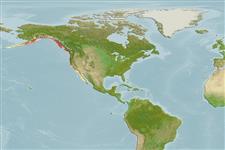Common names from other countries
Classification / Names / Names
Namen | Synonyme | Catalog of Fishes (gen., sp.) | ITIS | CoL | WoRMS
Environment: milieu / climate zone / depth range / distribution range
Ökologie
; tiefenbereich 0 - 40 m (Ref. 290). Temperate
Eastern Pacific.
Length at first maturity / Size / Gewicht / Alter
Maturity: Lm ? range ? - ? cm Max length : 13.0 cm TL Männchen/unbestimmt; (Ref. 290)
Girdle: Black leathery covering almost the entire dorsal area. Dorsal ridge area of each valve: small portion; left exposed (Ref. 296).
Surf-zone to 40 m. Usually found on stony or rocky bottoms (Ref. 290); in the middle intertidal zone from Alaska to Point Conception; North of Santa Barbara; also on rocky shore with heavy wave action (Ref. 312). Herbivorous, feeding primarily on red and green algae and benthic diatoms (Ref. 312).
Life cycle and mating behavior
Geschlechtsreife | Fortpflanzung | Ablaichen | Eier | Fecundity | Larven
Members of the class Polyplacophora are mostly gonochoric. Life cycle: Eggs hatch into lecitotrophic planktonic trocophore larvae (no veliger stage) which later metamorphose and settle on the bottom as young adults.
Burghardt, G. and L. Burghardt. 2006. (Ref. 296)
IUCN Rote Liste Status (Ref. 130435)
CITES Status (Ref. 108899)
Not Evaluated
Not Evaluated
Nutzung durch Menschen
| FishSource |
Tools
Mehr Information
Alter/GrößeWachstumLänge-GewichtLänge-LängeMorphologieLarvenDichte
Internet Quellen
Estimates based on models
Preferred temperature
(Ref.
115969): 6.1 - 10.9, mean 8.9 (based on 94 cells).
Verwundbarkeit
Low vulnerability (10 of 100).
Preiskategorie
Unknown.
